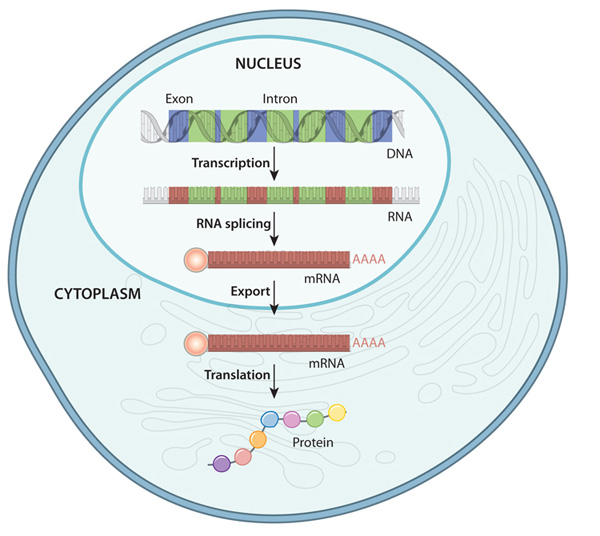Which Of The Following Is Not An Example Of The Control Of Gene Expression After Transcription
The amounts and types of mRNA molecules in a prison cell reflect the function of that prison cell. In fact, thousands of transcripts are produced every second in every jail cell. Given this statistic, it is non surprising that the primary control point for cistron expression is usually at the very outset of the protein product process — the initiation of transcription. RNA transcription makes an efficient control point because many proteins can be fabricated from a single mRNA molecule.
Transcript processing provides an additional level of regulation for eukaryotes, and the presence of a nucleus makes this possible. In prokaryotes, translation of a transcript begins before the transcript is complete, due to the proximity of ribosomes to the new mRNA molecules. In eukaryotes, however, transcripts are modified in the nucleus before they are exported to the cytoplasm for translation.
Eukaryotic transcripts are likewise more than complex than prokaryotic transcripts. For example, the primary transcripts synthesized by RNA polymerase contain sequences that will not be part of the mature RNA. These intervening sequences are called introns, and they are removed before the mature mRNA leaves the nucleus. The remaining regions of the transcript, which include the protein-coding regions, are called exons, and they are spliced together to produce the mature mRNA. Eukaryotic transcripts are also modified at their ends, which affects their stability and translation.
Of course, there are many cases in which cells must respond rapidly to irresolute environmental conditions. In these situations, the regulatory control betoken may come well after transcription. For case, early development in most animals relies on translational control because very lilliputian transcription occurs during the showtime few cell divisions after fertilization. Eggs therefore comprise many maternally originated mRNA transcripts equally a gear up reserve for translation after fertilization (Effigy 1).
On the degradative side of the balance, cells can rapidly arrange their poly peptide levels through the enzymatic breakdown of RNA transcripts and existing protein molecules. Both of these actions outcome in decreased amounts of sure proteins. Often, this breakup is linked to specific events in the cell. The eukaryotic prison cell wheel provides a good example of how poly peptide breakdown is linked to cellular events. This bicycle is divided into several phases, each of which is characterized past distinct cyclin proteins that act equally cardinal regulators for that stage. Before a prison cell can progress from 1 phase of the cell bike to the side by side, it must degrade the cyclin that characterizes that particular phase of the cycle. Failure to degrade a cyclin stops the cycle from continuing.

Figure 1: An overview of the period of information from DNA to protein in a eukaryote
Commencement, both coding and noncoding regions of Deoxyribonucleic acid are transcribed into mRNA. Some regions are removed (introns) during initial mRNA processing. The remaining exons are then spliced together, and the spliced mRNA molecule (red) is prepared for consign out of the nucleus through addition of an endcap (sphere) and a polyA tail. Once in the cytoplasm, the mRNA can be used to construct a poly peptide.
Which Of The Following Is Not An Example Of The Control Of Gene Expression After Transcription,
Source: https://www.nature.com/scitable/topicpage/gene-expression-14121669/
Posted by: russoyiestinne1990.blogspot.com


0 Response to "Which Of The Following Is Not An Example Of The Control Of Gene Expression After Transcription"
Post a Comment